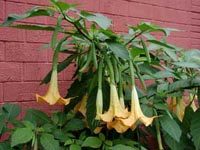Resource Library
Plant of the Week: Angel's Trumpet
The University of Arkansas System Division of Agriculture does not promote, support or recommend plants featured in "Plant of the Week." Please consult your local Extension office for plants suitable for your region.
Plant of the Week
Angel's Trumpet
Latin: Brugmansia aurea

Tropical plants have invaded our gardens in recent years, making us long for a stretch of sandy beach, a hammock and a cool ocean breeze as we enjoy the good life.
Most tropicals have lush foliage, but a few are grown for their flowers. Of these, angel’s trumpet (Brugmansia aurea) is perhaps the most spectacular.
Angel’s trumpet is a large shrub or small tree in the Columbian and Ecuadorian Andes where it grows at around 10,000 feet. It belongs to the nightshade family, the same family as the tomato and potato, but unlike them, all parts are poisonous. It reaches 20 feet tall and wide in the wild, but only a third of that in an Arkansas garden.
Leaves have a coarse texture and are 8 inches long. They also have a lush feel. But it’s the foot-long, trumpet-shaped yellow flowers that really give angel’s trumpet the exotic look. The fragrant, tubular flowers are borne singly and hang downward from the stems. The basal half of the floral tube is enclosed in a green calyx.
Blooms are produced from spring until fall, but heaviest flowering is in autumn. Cultivated forms have been extensively hybridized with selections available that produce pink, peach, red and white flowers. Both single and double-flowered forms are offered.
The angel’s trumpets were once botanically combined with the Daturas, which includes our native Jimson weed. Botanists seem to have finally agreed that they belong in separate genera. Datura has erect flowers that usually last only one day and a seed pod covered in stout thorns. Brugmansia has a smooth seed pod when one forms.
The revival of interest in angel’s trumpets began in the early 1990s when new plant
fever struck gardening. They weren’t really new, having been grown as conservatory
plants for more than a century, but they were generally unavailable except as cuttings
shared amongst friends.
The new plant craze in gardening coincided with a general movement to create more
lush, tropical looking gardens, so Brugmansias fit right in.
This increased availability and awareness had predictable results. In 2002, it spawned a society, the American Brugmansia & Datura Society, Inc. At last count, there were about 300 of these specialty plant societies. Almost every plant group or gardening style has its own society. These range from small, highly specialized societies like the American Penstemon Society and the afore mentioned Brugmansia society with a couple hundred members to large, well established groups like the American Orchid Society with 24,000 members.
The urge to focus gardening efforts on a single group of plants seems to be a common phenomenon. Because there’s so much to learn about the gentle art of gardening, the urge to specialize and know a lot about a narrow slice of the plant kingdom is appealing. Specialists share assistance, swap seeds and generally encourage one another as they pursue their passion. Google a plant group and include the word society, and you’ll be surprised what may pop up.
Angel’s trumpets are frost tender, so plants must be protected over winter. Established plants can be cut back severely and should be kept moist over winter in a cool bedroom. Plant them when you would set out tomatoes, giving them a sunny site with fertile, well-drained soil and ample water during the summer.
Overly exuberant growth or very slow growth results in few flowers, with the latter the most common cause of poor flowering. Spider mites are the most serious pest, especially inside during the winter.
By: Gerald Klingaman, retired
Extension Horticulturist - Ornamentals
Extension News - November 4, 2005
The University of Arkansas System Division of Agriculture does not maintain lists of retail outlets where these plants can be purchased. Please check your local nursery or other retail outlets to ask about the availability of these plants for your growing area.